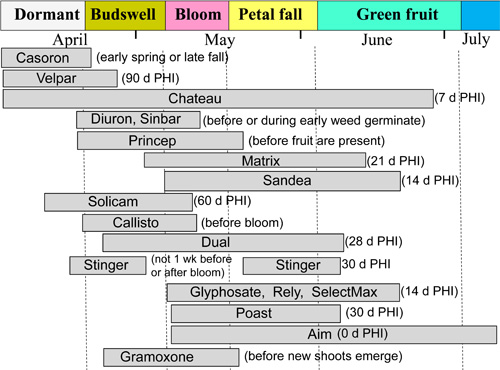Blueberry weed control: late spring and summer options
Blueberry weeds have already emerged, but several herbicides can still be used. Make sure you adhere to the pre-harvest intervals, which differ with each herbicide.
This early spring has made herbicide choices somewhat confusing. In addition, several new herbicides have been registered on blueberries. Most Michigan blueberries are in bloom now, so it is too late for some herbicides, but others can still be applied. If you were unable to get treatments on or they do not seem to be providing control, here are a few options. Consult MSU Bulletin E-154, Fruit Management Guide, for full herbicide recommendations and be sure to check and follow label instructions exactly, particularly preharvest intervals (PHI).
Pre- and post-emergent herbicides
All of these products can injure leaves and new shoots that are directly sprayed, so make sure you adjust nozzles to avoid hitting the base of bushes.
Chateau. The pre-harvest (PHI) interval for Chateau was shortened to seven days. Chateau controls many broadleaf and grass weeds, including chickweeds, dandelion, common groundsel, lambsquarters, eastern black nightshade, several pigweeds, ragweed, and most annual grasses. Chateau also provides some burn down of small weeds if combined with surfactant or crop oil concentrate (COC). Apply 6 to 12 oz of product per acre to bushes that have been in the field for two years or more.
Sandea has a PHI of 14 days, and provides preemergent and post-emergent control of many broadleaf weeds such as pigweed, ragweed, smartweed, and even yellow nutsedge. Treat nutsedge when three to five leaves are present. Two applications with non-ionic surfactant are most effective. The second application may need to be after harvest. Rates are 0.5 to 1.0 oz per acre and no more than 2 oz per year.
Dual Magnum is another effective herbicide on nutsedge, but has a 28 day PHI. Use only on bushes established at least one year. Use 0.67 oz. on young bushes on sandy soils and 1.33 oz. on large bushes on heavier soils. Only one application per season.
Stinger is a preemergent and post-emergent herbicide that is strong on weeds in the composite and legume families, such as thistle, asters, dandelion, goldenrod, ragweed, clovers, and wild bean or groundnut. It also controls nightshades, smartweeds, wild buckwheat and plantain. Stinger has a PHI of 30 days, but also should not be applied one week before to one week after bloom. This leaves a short window of time after bloom when Stinger can be used. Stinger is a growth regulator type herbicide and is most effective when weeds are up and growing shortly after bloom or after harvest. Rates are 2.6 to 5.3 fl oz per acre, and not more that 10.6 oz per season.
Matrix was just labeled for blueberries with a PHI of 21 days. Matrix controls a broad spectrum of annual grasses and broadleaf weeds. Do not use Matrix on sand soils or on bushes less than a year in the field. Apply 4.0 oz per acre once per year with non-ionic surfactant. Avoid contact with growing shoots and leaves. This product has the same mode of action as Sandea.
Selective grass herbicides
Three post-emergent grass herbicides are labeled for blueberries. These have no activity on blueberries or other broadleaf plants, but control annual grasses and suppress quackgrass when applied when grass is actively growing early in the season. SelectMax can be used on non-bearing and bearing bushes (PHI 14 days) at 9 to 16 fl oz per acre. Poast is another post-emergent grass herbicide for bearing (PHI 30 days) and non-bearing bushes. Fusilade is labeled only for non-bearing plants.
Post-emergent burn down materials
Several products can be used to kill emerged annual weeds and suppress or kill some perennials. All of these will damage green blueberry tissues (bark, leaves, fruit), so they need to be directed away from the crown of plants. Aim is a post-emergent burn down herbicide that is effective on small broadleaf seedlings, and has a zero-day PHI. It works well in combination with preemergent herbicides where weeds have already emerged. Aim can be applied up to harvest. Gramoxone and Rely (14 day PHI) are also burn down herbicides, but they control grasses and broadleaf weeds. Gramoxone should be applied before new blueberry shoots emerge (no PHI on label).




 Print
Print Email
Email



